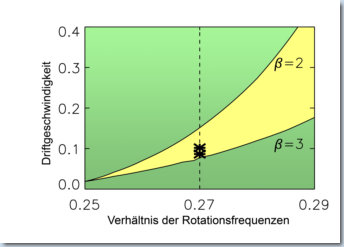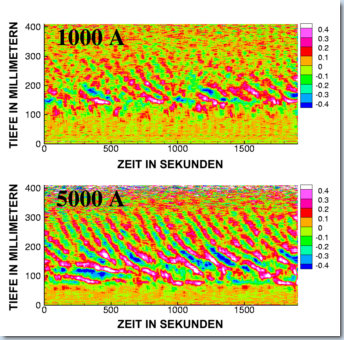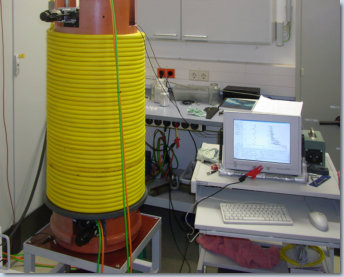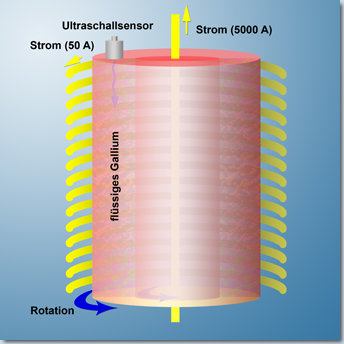The first experimental proof of the existence of a magnetic
effect was furnished which plays an essential role in the
cosmos, for example during the formation of stars. Magnetic
fields can generate turbulent motions in rotating, electrically
conducting fluids and gases. The name of the laboratory experiment
is PROMISE, the 'Potsdam-ROssendorf Magnetic InStability Experiment'.
The effect known from celestial bodies is called magnetorotational
instability. Different rotation periods at different distances
from the center cause shear in the fluid which is the main driver
of the instability. The effect was hitherto unknown in terrestrial
laboratories. Theory however predicted the instability for the
electrically conducting gases in the cosmos.
The idea and the physical computations come from the experts for
magnetic fields, Professor Günther Rüdiger at Astrophysikalisches
Institut Potsdam and Dr. Rainer Hollerbach at the University of
Leeds. The magnetohydrodynamics department of Forschungszentrum
Dresden-Rossendorf possessed the technical experience with fluid-metal
experiments for the implementation of the proof of the instability, headed by
Dr. Gunter Gerbeth and Dr. Frank Stefani. The project was one of the
awarded proposals for financial support from the Leibniz-Gemeinschaft.
Two coaxial cylinders rotate about their common axis.
The inner one rotated faster than the outer one. Gallium-Indium-Tin (GaInSn)
is filled in between the cylinders which is fluid at room temperatures.
Electrical currents generate the magnetic fields. A large
coil (yellow windings in Figure 1) yields a magnetic
field with vertically aligned field lines, a strong current
of a few thousand Ampere through the cylinder axis causes
a field with ring-like field lines threading the GaInSn.
The phenomenon of magnetorotational instability emerges
even for weak magnetic fields. A combination of rather strong
fields has to be used in the experiment though, since
the required rotation speeds would be much to high otherwise.
|

Figure 3: Drift velocity of the emerging flow patterns, theoretical (yellow area) and experimental (crosses).

Figure 4: Dependence of the vertical velocity on depth at various times. Top panel for 1000 Ampere, bottom panel for 5000 Ampere.
|
[Press release (in German)]
[MHD group at AIP]
[MHD group at FZD]
[AIP home page]
|
|
|

Figure 1: The experiment PROMISE.

Figure 2: Sketch of the PROMISE setup. The fluid GaInSn is located between two coaxial cylinders. The inner and outer cylinders rotate with different rotation periods. Ultrasonic sensors measure the vertical velocity of the fluid metal.
|
Many astronomical objects rotate faster in their interior than at the
surface. Because even weak magnetic fields are sufficient for the
onset of the instability, theorists suggest that phenomena like
star formation or the enormous luminosity of quasars can be explained
by the magnetorotational instability. While astronomers usually get
their information only from the light of distant worlds, PROMISE
is giving a new meaning to the term 'laboratory astrophysics'.
The onset of the instability is first observed in the emergence
of rolls in the fluid which drift with a certain velocity through
the GaInSn. Figure 3 shows the drift velocity of the rolls
in dependence on the ratio of rotation speeds of the two
cylinders. At a rational ratio of 0.25, one rotation of the outer
cylinder lasts four times longer than a rotation of the inner
cylinder. The measurements by theory were predicted to lie in the
yellow area. Two drift velocities were determined
which indeed lie in the predicted area (crosses).
Ultrasound probes "look" into the gap between the two
cylinders from above and measure the vertical motions
of the fluid metal. If the roll-type motions emerge,
a certain pattern of alternating velocity directions
is observed, depending on depth. These drift vertically
with time and give the drift speed. If the current
through the axis has 1000 Ampere, the motions are still
weak. At 5000 Ampere, the drifting rolls are indicated
by inclined areas marked in red in Figure 4.
PI PROMISE
Prof. Günther Rüdiger
Astrophysikalisches Institut Potsdam
An der Sternwarte 16
D-14482 Potsdam
(0331) 7499 512

Press contact
Ms Shehan Bonatz
(0331) 7499 469

Publications
G. Rüdiger, R. Hollerbach, F. Stefani, T. Gundrum, G. Gerbeth, R. Rosner:
The traveling wave MRI in cylindrical Taylor-Couette flow: comparing wavelengths and speeds in theory and experiment.
Astrophysical Journal Letters, in press. astro-ph/0607041
|


 last change 2007 February 28, R. Arlt
last change 2007 February 28, R. Arlt


